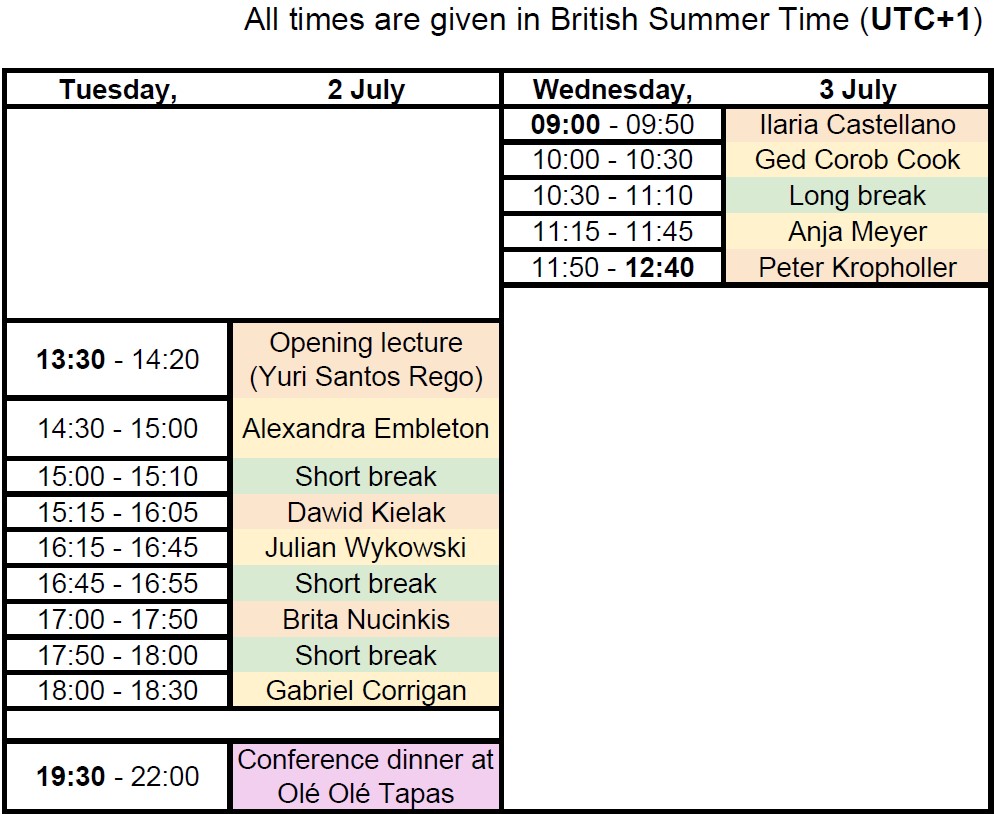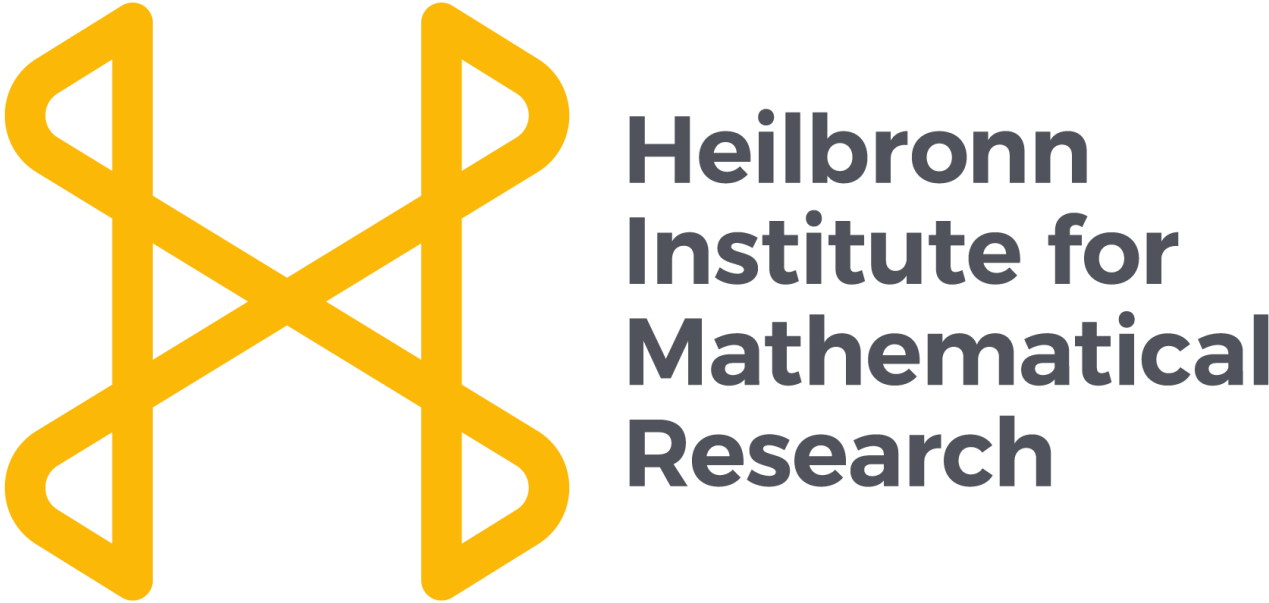Mini-Workshop: Trending Aspects in Group Cohomology
2-3 July 2024, Lincoln, UK
Schedule
The programme will start at 13:30 on Tuesday (2 July) and end around 12:45 on Wednesday (3 July). The timetable is shown below.
Abstracts
Ilaria Castellano
Totally disconnected locally compact groups, accessibility and Euler-Poincaré characteristicGiven a finitely generated group, thanks to the Stallings' decomposition theorem, it may be possible to split the group over a finite subgroup into pieces which in turn could split again. If this process terminates, i.e., it is not possible to continue splitting the group ad infinitum, the group is said to be accessible. In this talk I will first illustrate how the notion of accessibility carries over to the realm of totally disconnected locally compact (=t.d.l.c.) groups, and then move the attention to the t.d.l.c. groups of rational discrete cohomological dimension one. For these groups one can exploit the Euler-Poincaré characteristic to obtain an analogue of Linnell's theorem on the accessibility of finitely generated groups whose finite subgroups have bounded order.
Ged Corob Cook
Hierarchically decomposable tdlc groupsKropholler's class of hierarchically decomposable groups has many nice properties. For example, groups G of type \(\mathtt{FP}_\infty\) in this class have a bound on the orders of finite subgroups, and have finite dimensional classifying spaces \(\mathrm{E}_{F}G\) with respect to the family F of finite subgroups. Totally disconnected, locally compact (tdlc) groups introduce some new difficulties, because the category of discrete \(\mathbb{Z}[G]\)-modules does not have enough projectives, but we can still obtain many similar results to the case of discrete groups. I will survey what is known, and show that soluble tdlc groups of type \(\mathtt{FP}_\infty\) have finite dimensional classifying spaces with respect to the family of compact open subgroups.
Gabriel Corrigan
Realising the virtual cohomological dimension of automorphism groups of RAAGsIn 1986, Culler & Vogtmann introduced 'Outer space' - a complex upon which \(\mathrm{Out}(F_n)\), the outer automorphism group of a free group, acts properly. This had many applications; one is that the dimension of the so-called 'spine' of Outer space is precisely the virtual cohomological dimension (VCD) of \(\mathrm{Out}(F_n)\). More recently, Charney-Stambaugh-Vogtmann constructed an 'untwisted Outer space' - an analogous space used for studying the group of untwisted automorphisms of a right-angled Artin group. However, in a departure from the free group case, sometimes the dimension of this rather natural 'untwisted spine' is larger than the VCD of the corresponding group of outer automorphisms! In this talk I will present work examining this phenomenon. I present graph-theoretic conditions under which we can perform an equivariant deformation retraction of the untwisted spine to produce a new complex which geometrically realises the VCD of the group of untwisted automorphisms. As a corollary, this proves that the gap between the VCD of the untwisted subgroup and the dimension of the untwisted spine can be arbitrarily large.
Alexandra Embleton
Cohomological invariants of Bredon modulesGiven the orbit category, \(\mathcal{O}_{\mathfrak{F}}G\), for any given family \(\mathfrak{F}\) of subgroups, we define a Bredon module to be a functor \(M(-):\mathcal{O}_{\mathfrak{F}}G \rightarrow \mathfrak{Ab}\). From this one can define the notion of free, projective, injective and Bredon-Gorenstein projective modules and related cohomological invariants. Subsequently some results, analogous to those known in other cases, can be proved for Bredon modules relating invariants such as \(silp_{\mathfrak{F}}G\), \(spli_{\mathfrak{F}}G\), \(cd_{\mathfrak{F}}G\), \(gldim_{\mathfrak{F}}G\), \(fin.dim_{\mathfrak{F}}G\) and \(Gcd_{\mathfrak{F}}G\).
Dawid Kielak
One-relator groupsI will discuss recent progress in our understanding of one-relator groups.
Peter Kropholler
A condensed approach to Corob Cook's theoremAnja Meyer
Towards the cohomology of \(\mathrm{SL}_2(\mathbb{Z}/p^n)\)The cohomology of matrix groups with entries in fields or infinite rings is well studied. In this talk we will move to matrix entries in \(\mathbb{Z}/p^n\) for n > 1 and study the mod p cohomology of the Sylow p-subgroups \(S_n\) of \(\mathrm{SL}_2(\mathbb{Z}/p^n)\), presenting the results from my PhD thesis. In the first part of the talk we will explore important characteristics of \(S_n\). Then we will fix p = 3 and work through the computation of their mod 3 cohomology by using the Lyndon-Hochschild-Serre spectral sequence. Finally there will be a short discussion about how this fits into the computation of \(H^*(\mathrm{SL}_2(\mathbb{Z}/p^n), \mathbb{F}_p)\).
Brita Nucinkis
On cohomological finiteness conditions for topological groupsIn this talk I will give an introduction to analogues to the classical finiteness conditions \(\mathtt{FP}_n\) for totally disconnected locally compact groups. I will present a construction of non-discrete tdlc groups of arbitrary finiteness length. As a bi-product we also obtain a new collection of (discrete) Thompson-like groups which contains, for all positive integers n, groups of type \(\mathtt{FP}_n\) but not of type \(\mathtt{FP}_{n+1}\). This is joint work with I. Castellano, B. Marchionna, and Y. Santos Rego.
Yuri Santos Rego
Arithmetic groups and their cohomological finiteness propertiesCohomological data about arithmetic groups is of great importance in algebra, geometry, topology, and number theory.
In this talk we will give an overview of some cohomological properties of (S-)arithmetic groups by means of examples, prominent results, and key 'parameters' in the theory.
Julian Wykowski
Profinite recognition of amalgamated factorsCan one detect amalgamated factors in the finite quotients of a group? In this talk, we will find out that the answer is “yes” for virtually free groups. I will introduce the theory of profinite groups acting on profinite trees and present an accessibility result which connects graph of profinite groups decompositions to cohomology. We will then explore how this result implies that amalgamated factors of virtually free groups along finite amalgamation are always visible in the collection of finite quotients of the ambient group.



